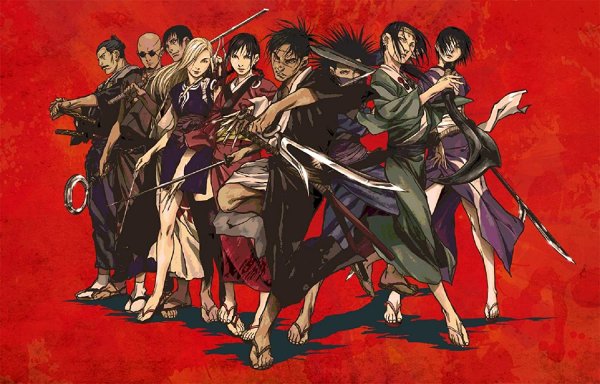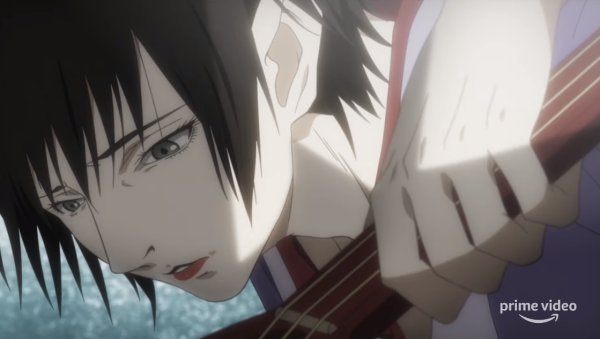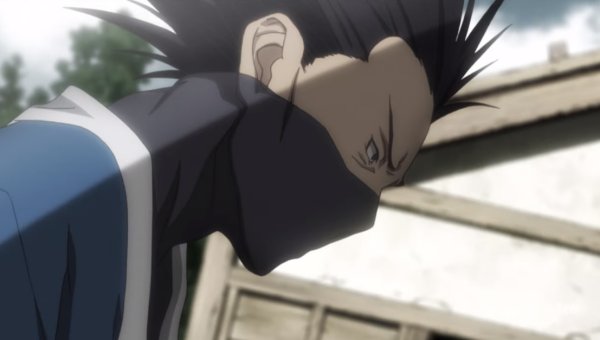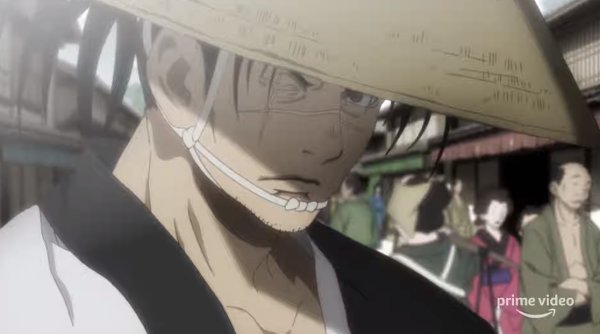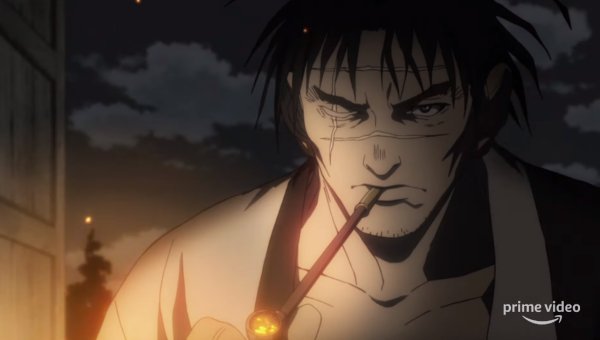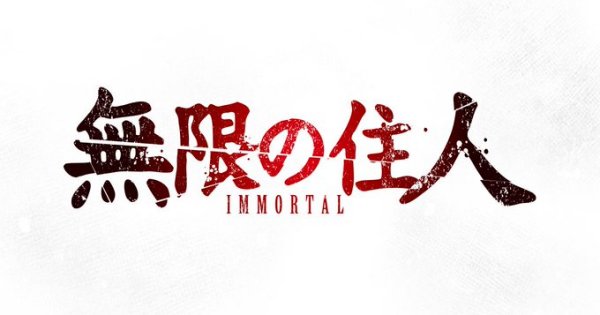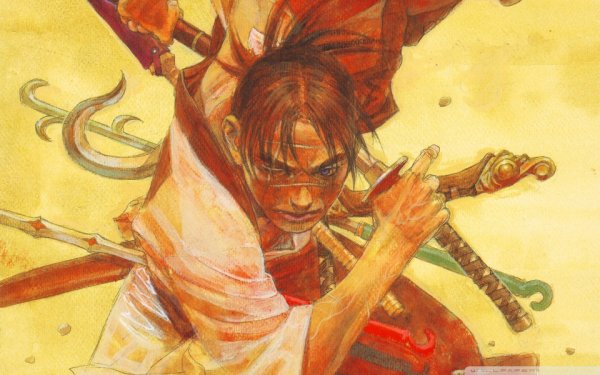 Sometimes a curse can be used to help others.
Sometimes a curse can be used to help others.
What They Say:
Damned to wander the Earth in an endless cycle of carnage and murder, the fallen samurai known as Manji seeks the chance to win back his mortality. To do so, he must first balance the deaths weighing against him by slaying 1000 evil souls, a task that would take even the greatest warriors a lifetime.
Manji, however, has all the time in the world to kill, and his lonely quest leaves a trail of bloody bodies in his wake… until his path crosses with that of Rin, who has sworn vengeance against the murderers of her family and school, even though the cost will almost certainly be her own life. Now, the girl who chases death has an unkillable sword master at her side, and the men she seeks will soon learn to fear the Blade of the Immortal!
The Review:
Audio:
The audio presentation for this release brings us the original Japanese language in stereo along with the English language dub, both of which are encoded using the DTS-HD MA lossless codec. The series has a decent mix of action pieces in it with sword fights and more that’s handled well through both mixes well. There’s a lot of steel used in this show and a lot of blood flowing from the attacks and it’s captured pretty well across the forward soundstage. The time metal meets metal definitely hits very well and the squish if flesh sliced open lands just right. The dialogue side of it for both are pretty similar with a standard approach to placement with some depth from time to time. It’s a kind of conventional show in a lot of ways and it hits some decent notes along the way as it unfolds. Dialogue is clean and clear throughout and we didn’t have any problems with dropouts or distortions during regular playback.
Video:
Originally airing in 2019 and 2020, the transfer for this TV series is presented in its original aspect ratio of 1.78:1 in 1080p using the AVC codec. The twenty-four episodes are spread across three discs in an eight/eight/eight breakdown. Animated by Liden Films, the series has a really solid look to it with distinctive character designs and a mildly soft filter that helps to bring it all together. It’s one that i think captures the look and feeling of the manga really well, which is hugely distinctive in a lot of ways, without compromising itself much. The outfits and the character designs definitely have Samura’s particular style about them and it flows well throughout. The encoding for this works really well as it brings all of that detail and color design to life in a great way. It’s nicely done with a clean and problem-free encode as there’s no noise to be had or breakup throughout. I really loved the look of it as it adapts the manga as it gives it a great life here.
Packaging:
The packaging for this set comes in a standard-sized Blu-ray case where we get a hinge to hold two of the three discs. The front cover works the familiar key visual that’s definitely very busy as it features the expansive cast for the show with all of its rough details and artwork combined with earth tones that keeps it from really standing out. But with the blood-red behind it and the white dripping down from the time to reverse things, it looks quite good and definitely catches the eye very well. The back cover works the dark reds and black colors nicely with a good collage of shots along the top and a solid and slightly lengthy summary of the premise through the middle. The layout works really well to feel distinctive yet familiar at the same time because of the elements for it. The remainder is given over to the usual logos, production credits, and a clean but far too small technical grid. No show related inserts are included but we do get a nice two-panel page spread of character artwork.
Menu:
The menu design goes for a simple but effective approach with its static design. The layouts provide for a good paper-style navigation strip along the bottom where you get the episodes by number and title with some nice design elements to them with the rough ink work. The main visual behind it is done with shades of blood red that has lots of splatters across it to give it that added effect. The logo is kept to the side while next to it we get some good character artwork across the three discs, showing the designs and detail. With language options easy to select and minimal extras overall, navigation is a breeze and the whole thing works easily and problem-free.
Extras:
The only extras included with this release are the clean versions of the opening and closing sequences.
The Blade of the Immortal property is one that I have a particular love for. Back when there weren’t a lot of manga being released in English, this series from Hiroaki Samura was being released by Dark Horse Comics in floppy form and specifically requested, I believe at the time, for it not to be done in traditional Japanese format even though it caused some problems. And then there’s the whole issue of the symbol used and its closeness to the Nazi symbol. At that time and my then meager knowledge of manga, it was easy to put that to the side and just enjoy the world that Samura had put together because you would not find anything else like it on the direct market stands every week. It stood out for its violence and design and the intensity it played through with wild abandon.
That series ran from 1993 to 2012 and we saw a few different iterations of trades released for it, usually in oversized form to really soak up the artwork, but I lost track along the way and never finished. A single-season TV adaptation was done back in 2008 by Bee Train but that’s largely lost to the past at this point, a decent attempt that couldn’t quite capture things. With the way remakes and “complete” adaptations are being done, it was a welcome surprise when this series ended up landing in 2019 – coming two years after the live-action film – and coming in as a two-cour piece that saw exclusive streaming on Amazon Prime Video. Thankfully, Sentai was able to grab the home video release rights for it and we get to check that bilingual release out and enjoy more of the adventures of Manji and Rin.
The premise for the series is relatively straightforward. Its central character of Manji is really solid as he’s a skilled and exceptional swordsman who has only become moreso since becoming immortal. Outside of poisoning, he’s been “gifted” with this endless life by a centuries-old nun to make amends for his past. With actions that have him labeled a criminal and responsible for the death of a hundred other samurai, he’s been tasked with eliminating a thousand evil men from the world and only then will the “sacred bloodworms” that inhabit his body depart. They’re disturbing but fascinating things that help him repair, heal, and regrow but they can do only so much, hence unable to deal with poison and the like. But we even have moments where a severed limb can be repaired. The anime handles this well, but I’ll admit there’s something that was just more captivating in the manga with it.
While Manji is basically living this solitary existence in his hunt for evil men in order to absolve himself of his crimes, the pivotal figure that comes into his life is that of Rin, a young woman who seeks his help in order to avenge her parents. With Manji largely being alone for so long and just focused on his eliminations, Rin brings someone for him to talk and to help bring him back to something more than just a killing machine. He very much is one but it doesn’t become his sum total and having someone to protect definitely helps. But it’s also useful in the big picture side of thing as the man that killed her parents is a master swordsman named Kagehisa, who is building his own dojo by eliminating others and taking on outcasts and using dark and dishonorable methods through which to win fights. This provides for plenty of opponents for Manji to deal with and a reason for Rin to be a source of contention for Kagehisa since he dislikes leaving too much behind from his kills.
The series works a familiar pattern that may be more problematic when binging than on a weekly basis as the first third of the show is essentially a villain of the week thing. It’s designed to get us familiar with both Manji and Run and then to show how he fights, work out the kinks in the animation for making sure they’re as bloody as they can get away with, and to help build the dynamic and relationship between the two. With it being a two-cour series it can give over this much time easily enough to do so, but if you’re binging it may be a bit much. But when it shifts to the larger story with Kagehisa, things take on a more layered approach with a lot of characters coming in that aren’t eliminated after an episode or two but rather become recently recurring pieces, giving it all a lot more depth to work with, especially with some of the verbal sparring.
While a lot of this does play out in somewhat standard fare in regards to the larger storyline, there is a lot within it that makes it a thoroughly engaging experience. Manji is the kind of character that you can get behind because while he has picked up a lot of skill since becoming immortal, he is facing people that are far better than him and he regularly gets taken down in hard ways. Granted, he can recover from these things but it’s not without pain and real damage to him, especially the mental toll that it takes. But it also reminds us that his condition is because of his crime and as we see so many other evil men here and get involved in their backstories along the way, it really blurs things. I won’t say they’re all humanized in a way where you sympathize with them, but there are times when choices made can be understood and why they ended up on the path that they’re on. All of this nuance makes it a far more engaging piece than other works where we may get a snippet at most or they’re almost caricatures of villains with the usual cliches.
In Summary:
I’ve long loved this property and while I don’t think anime or live-action can truly capture the manga, this one does a really admirable job with it. The cast for both tracks are solid and engaging in their performances, the visual design doesn’t hold back from the violence and bloodshed, and they do a really good job of capturing the aesthetic of the manga itself while knowing it just doesn’t translate in a 1:1 kind of way. It’s a slow burn at the start but it draws you into this world and what they’re all doing and why before it shifts to the larger narrative and expands on everything. Sentai’s release is rock solid here as the encoding looks great, the colors are exactly where they need to be, and it sounds fantastic. I’m naturally disappointed in the extras a bit with just the promos but these things happen sometimes for various reasons. The core show itself is what matters in the end and it’s a solid entry there.
Features:
Japanese DTS-HD MA 2.0 Language, English DTS-HD MA 2.0 Language, English Subtitles, Japanese Promos
Content Grade: B+
Audio Grade: B+
Video Grade: B+
Packaging Grade: B
Menu Grade: B
Extras Grade: C
Released By: Sentai Filmworks
Release Date: January 19th, 2021
MSRP: $89.98
Running Time: 600 Minutes
Video Encoding: 1080p AVC
Aspect Ratio: 1.78:1 Widescreen
Review Equipment:
Sony KDL70R550A 70″ LED 1080P HDTV, Sony PlayStation3 Blu-ray player via HDMI set to 1080p, Onkyo TX-SR605 Receiver and Panasonic SB-TP20S Multi-Channel Speaker System With 100-Watt Subwoofer.


